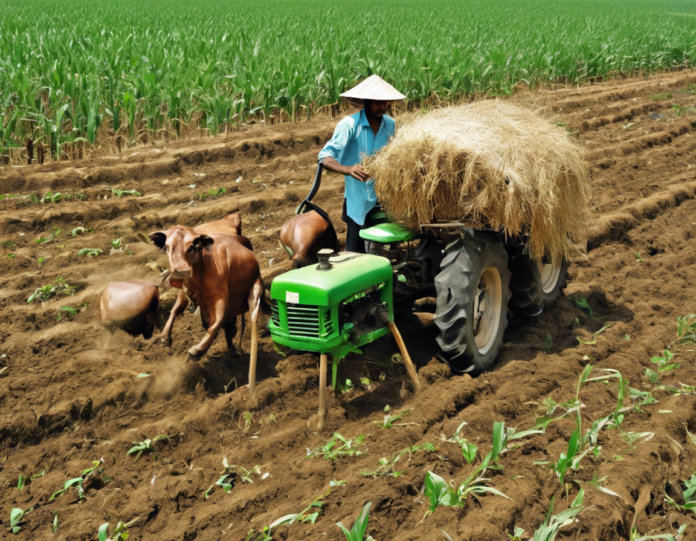Introduction
Agriculture in India is an essential sector of the country’s economy, employing a significant portion of the workforce and contributing significantly to its GDP. The agricultural practices in India have evolved over the years, adapting to various challenges and technological advancements. In this comprehensive guide, we will delve into various aspects of agriculture in India, including its significance, challenges, government initiatives, and future prospects.
The Significance of Agriculture in India
Agriculture has been the primary source of livelihood for a large section of the Indian population. It not only provides employment to a significant portion of the workforce but also sustains a vast rural economy. The agricultural sector in India also plays a crucial role in food security, ensuring a steady supply of essential commodities to the growing population.
Types of Agriculture in India
India is known for its diverse agricultural practices, owing to its varied agro-climatic conditions. The primary types of agriculture practiced in India include:
-
Subsistence Agriculture: Predominant in rural India, subsistence agriculture focuses on producing just enough to meet the basic needs of the farmer and his family.
-
Commercial Agriculture: This type of agriculture involves the production of crops and livestock for sale in the market. Commercial agriculture is becoming increasingly important in the wake of market globalization.
-
Organic Farming: With a growing emphasis on sustainability and health, organic farming is gaining popularity in India. It involves the use of natural fertilizers and pesticides to grow crops.
Challenges Faced by Indian Agriculture
Despite its significance, Indian agriculture faces several challenges that hinder its growth and sustainability. Some of the key challenges include:
-
Small Land Holdings: The fragmentation of land holdings in India is a significant issue, leading to inefficiencies in production and lower yields.
-
Climate Change: Erratic weather patterns, floods, droughts, and other climate-related factors pose a significant threat to agricultural productivity in India.
-
Lack of Infrastructure: The inadequate infrastructure in rural areas, including irrigation facilities, storage facilities, and market linkages, hinders the growth of the agricultural sector.
Government Initiatives to Boost Agriculture
Recognizing the importance of agriculture in India, the government has launched various initiatives to support farmers and enhance agricultural productivity. Some of the key government schemes and programs include:
- Pradhan Mantri Fasal Bima Yojana: This crop insurance scheme aims to provide financial support to farmers in case of crop failure due to natural calamities.
- Pradhan Mantri Kisan Samman Nidhi (PM-Kisan): Under this scheme, small and marginal farmers receive direct income support of Rs 6,000 per year.
- National Agriculture Market (eNAM): eNAM is an online trading platform that aims to connect agricultural produce market committees (APMCs) across the country, promoting transparent and competitive trading.
- Soil Health Card Scheme: This scheme provides farmers with soil health cards containing information about the nutrient status of their soil and recommendations for appropriate fertilizers.
Future Prospects of Agriculture in India
Despite the challenges, the future of agriculture in India looks promising with the adoption of technology, sustainable practices, and government support. Some key trends shaping the future of Indian agriculture include:
- Technological Advancements: The adoption of technology such as precision agriculture, drones, and IoT devices is transforming the agricultural landscape in India, leading to increased efficiency and productivity.
- Sustainable Agriculture: There is a growing emphasis on sustainable agricultural practices in India, including organic farming, conservation agriculture, and water management techniques.
- Market Diversification: With changing consumer preferences and global market trends, there is a shift towards diversification of crops and value-added products in Indian agriculture.
Frequently Asked Questions (FAQs)
-
What percentage of the Indian population is engaged in agriculture?
Approximately 58% of the Indian population is engaged in agriculture and allied activities. -
Which are the major crops grown in India?
Major crops grown in India include rice, wheat, sugarcane, cotton, and pulses. -
How does the government support agriculture in India?
The government supports agriculture through various schemes such as PM-Kisan, crop insurance, soil health cards, and market reforms. -
What are the key challenges faced by Indian farmers?
Indian farmers face challenges such as small land holdings, climate change, lack of infrastructure, and market volatility. -
How is technology changing Indian agriculture?
Technology is revolutionizing Indian agriculture through the adoption of precision agriculture, drones, IoT devices, and digital market platforms.
Conclusion
In conclusion, agriculture in India is a vital sector that sustains millions of livelihoods and contributes significantly to the country’s economy. Despite facing various challenges, Indian agriculture is witnessing transformation through technological advancements, sustainable practices, and government support. With continued focus on innovation and resilience, the future of Indian agriculture appears promising, paving the way for a more prosperous and sustainable agricultural sector.









